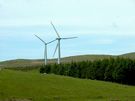RSPB wants increase in UK wind farms
The RSPB believes that more onshore wind farms in the UK will counter the effects of climate change on wildlife


A new report for the RSPB, written by the Institute for European Environmental Policy (IEEP), has called for an end to ‘needless delays’ that are interfering with British wind farm projects.
The report suggests that, with an effective planning system, it would be possible to greatly increase the number of onshore wind farms without harming wildlife.
The RSPB suggests that a ‘bird sensitivity map’ should be drawn up in order to identify areas that should not be chosen as wind turbine sites, such as those with large numbers of nesting seabirds or which are habitats for rare birds of prey.
This is a U-turn in policy for the RSPB, which had previously been a strong critic of wind farms, leading the campaign to prevent the construction of a wind farm on the Isle of Lewis.
Ruth Davis, head of climate change policy at the RSPB, said: ‘Climate change threatens many species with extinction, but that sense of urgency is not translating into actions on the ground to harness the abundant wind energy around us.
‘We must reduce the needless delays that beset wind farm development. This report shows that the UK can produce huge amounts of clean energy without time-consuming conflicts and harm to our wildlife.’
The RSPB is pressuring the Government to set clear local and regional targeting for wind development and to guide local councils on dealing with planning applications, in order to avoid projects being delayed by local politics.
Sign up for the Country Life Newsletter
Exquisite houses, the beauty of Nature, and how to get the most from your life, straight to your inbox.
The charity also believes that more effort should be made to win local-community support—for example, by offering cheaper energy to those living close to a wind farm.
A spokesman for the Department of Energy and Climate Change said that the Government is committed to a national increase in the use of renewable energy sources, ‘including both onshore and offshore wind farms’.
However, Britain is only thirteenth in the league table of onshore wind energy in Europe, measured by head of population, with less than 2% of its electricity coming from wind in 2007, compared with 29% in Denmark, 20% in Spain and 15% in Germany.
Britain is legally committed to increasing its use of renewable energy sources to 15% of energy consumption by 2020. David Baldock, director of the IEEP, said: ‘The development of rewnable energy in Britain has to accelerate greatly if new, binding targets are to be met.
‘Damage to wildlife can be minimised by guiding turbines to the right sites. Good planning can facilitate development appropriate for the long term.’
Ed Miliband, the climate change minister, has gone further, claiming that opposing wind farms is as ‘socially unacceptable’ as ‘not wearing your seat belt or driving past a zebra crossing’.
This view has been attacked by the Campaign for the Protection of Rural England (CPRE). A spokesman said: ‘We don't think you can take such an uncritical line. With any development—whether it's housing or turbines—there are going to be some locations that are right and some that aren’t.’
About 7,000 new wind turbines have been planned for the UK in order to meet EU targets. A coalition of countryside campaigners, including the CPRE, has warned that vast swathes of Britain’s most beautiful countryside could be blighted as a result.
To comment on this article, use the comment box below, or email us at clonews@ipcmedia.com. Read more about the countryside
Country Life is unlike any other magazine: the only glossy weekly on the newsstand and the only magazine that has been guest-edited by HRH The King not once, but twice. It is a celebration of modern rural life and all its diverse joys and pleasures — that was first published in Queen Victoria's Diamond Jubilee year. Our eclectic mixture of witty and informative content — from the most up-to-date property news and commentary and a coveted glimpse inside some of the UK's best houses and gardens, to gardening, the arts and interior design, written by experts in their field — still cannot be found in print or online, anywhere else.
-
 A well-connected rural playground with 23 acres on the edge of the South Downs National Park
A well-connected rural playground with 23 acres on the edge of the South Downs National ParkOld House Farm is an impressive family home with a wealth of amenities that would inspire any rural passion.
By Arabella Youens Published
-
 The UK gets its first ‘European stork village’ — and it's in West Sussex
The UK gets its first ‘European stork village’ — and it's in West SussexAlthough the mortality rate among white storks can be up to 90%, the future looks rosy for breeding pairs in southern England.
By Rosie Paterson Published
